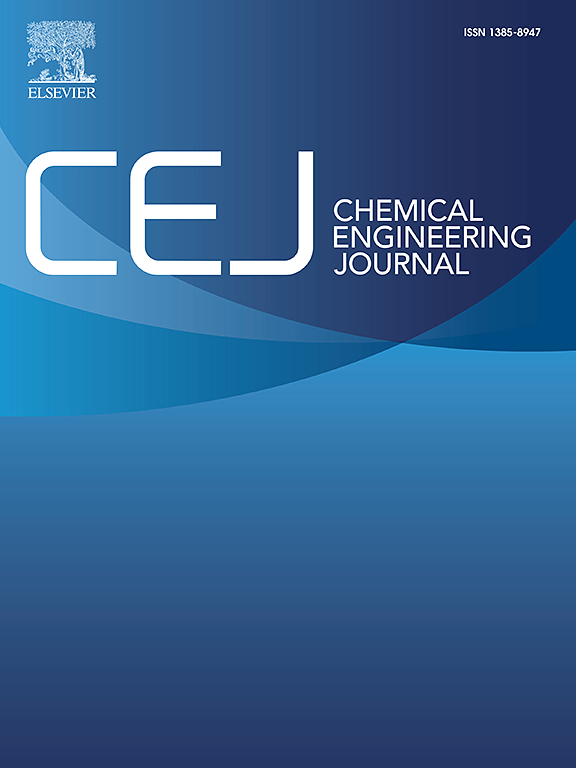Ultra-linear, highly sensitive fabric strain/temperature sensor via the regulation of reduced graphene oxide defect and carrier migration for physiological risk alerts
IF 13.2
1区 工程技术
Q1 ENGINEERING, CHEMICAL
引用次数: 0
Abstract
With increasing public attention to health and the rapid development of the Internet of Things, multifunctional wearable sensors capable of detecting diverse physiological signals have emerged as a critical research focus. This study proposes a fabric-based dual-function sensor with both strain and temperature-sensing capabilities. Lycra cotton was selected as the substrate, and a sensing unit was integrated through repeated impregnation and drying processes. Graphene (GR) exhibits excellent mechanical strain characteristics, while reduced graphene oxide (rGO) demonstrates superior thermal conductivity. Silicone rubber (SR) possesses high compatibility with fabric substrate and can work in synergy with rGO and GR to form a three-dimensional conductive network. By adjusting the rGO/GR ratio and dip-coating cycles, the effects on the sensitivity and linearity (strain-sensing) were investigated, and sensors with the optimal ratio were selected for performance evaluation. A physical model inspired by soil microstructure was introduced to elucidate the strain-sensing mechanism. The sensor achieved a high sensitivity of 15.081 and a linearity of 0.9955. GR adheres to rGO interfaces via SR, creating smooth pathways for carrier migration, and the resulting 3D conductive network can be used to explain the temperature-sensing mechanism. The sensor demonstrated a temperature detection range of 22–50 °C with a temperature coefficient of resistance of −1.438 %°C−1, maintaining high linearity (0.9915). As a proof of concept, the sensor was successfully applied to infant sleeping posture monitoring and hazardous motion warning. This dual-mode, fabric-based bioelectronic device holds promise for enabling multimodal sensing strategies in intelligent health monitoring systems.超线性、高灵敏度织物应变/温度传感器,通过减少氧化石墨烯缺陷和载流子迁移来调节生理风险警报
随着人们对健康的关注和物联网的快速发展,能够检测多种生理信号的多功能可穿戴传感器成为一个重要的研究热点。本研究提出了一种基于织物的双功能传感器,具有应变和温度传感能力。选择莱卡棉作为衬底,通过反复浸渍和干燥过程集成传感单元。石墨烯(GR)表现出优异的机械应变特性,而还原氧化石墨烯(rGO)表现出优异的导热性。硅橡胶(SR)与织物基材具有较高的相容性,可与还原氧化石墨烯和GR协同作用形成三维导电网络。通过调整rGO/GR比和浸涂周期,考察了对传感器灵敏度和线性度(应变传感)的影响,并选择了最佳配比的传感器进行性能评价。引入了受土壤微观结构启发的物理模型来解释应变传感机理。该传感器的灵敏度为15.081,线性度为0.9955。GR通过SR附着在rGO界面上,为载流子迁移创造了平滑的路径,由此产生的3D导电网络可以用来解释温度传感机制。该传感器的温度检测范围为22-50 °C,电阻温度系数为- 1.438 %°C - 1,保持高线性度(0.9915)。作为概念验证,该传感器已成功应用于婴儿睡姿监测和危险动作预警。这种双模、基于织物的生物电子设备有望在智能健康监测系统中实现多模态传感策略。
本文章由计算机程序翻译,如有差异,请以英文原文为准。
求助全文
约1分钟内获得全文
求助全文
来源期刊

Chemical Engineering Journal
工程技术-工程:化工
CiteScore
21.70
自引率
9.30%
发文量
6781
审稿时长
2.4 months
期刊介绍:
The Chemical Engineering Journal is an international research journal that invites contributions of original and novel fundamental research. It aims to provide an international platform for presenting original fundamental research, interpretative reviews, and discussions on new developments in chemical engineering. The journal welcomes papers that describe novel theory and its practical application, as well as those that demonstrate the transfer of techniques from other disciplines. It also welcomes reports on carefully conducted experimental work that is soundly interpreted. The main focus of the journal is on original and rigorous research results that have broad significance. The Catalysis section within the Chemical Engineering Journal focuses specifically on Experimental and Theoretical studies in the fields of heterogeneous catalysis, molecular catalysis, and biocatalysis. These studies have industrial impact on various sectors such as chemicals, energy, materials, foods, healthcare, and environmental protection.
 求助内容:
求助内容: 应助结果提醒方式:
应助结果提醒方式:


